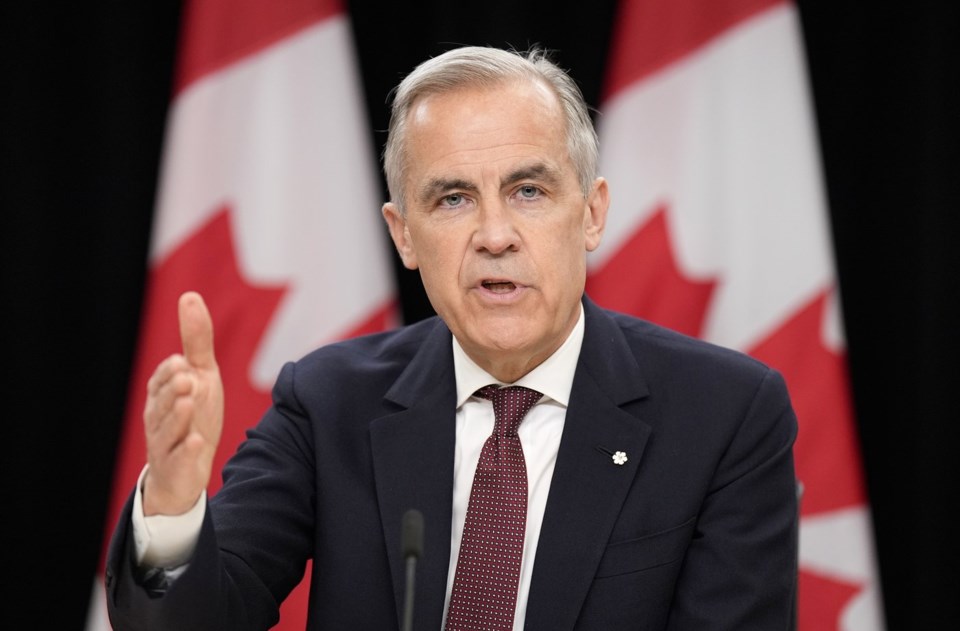OTTAWA — Canada will finally meet its NATO defence spending commitment this year as it confronts an alarming new world of threats, Prime Minister Mark Carney said in Toronto Monday morning.
Carney said Canada will rapidly advance its military spending timeline to hit the NATO target of two per cent of national GDP.
“Canada will achieve NATO’s two per cent target this year, half a decade ahead of schedule,” the prime minister said, promising to accelerate that timeline again within the next few years.
Carney said Canada's defence is too dependent on an increasingly unreliable United States and his government will look to partner more with European allies it moves to build up the domestic industrial base.
“The United States is beginning to monetize its hegemony, charging for access to its markets and reducing its relative contribution to our collective security,” he warned.
The federal government currently is spending about 1.45 per cent of GDP on defence and has not hit the two per cent target since 1990 — despite having promised its biggest allies for years that it would.
Canada has come under intense pressure from its allies to swiftly increase its military budget to levels not seen since the Cold War.
Monday's announcement comes just ahead of a major NATO meeting in the Netherlands set for later this month. Allied nations are expected to adopt a plan at that meeting to hike the NATO member spending target to five per cent of national GDP — a level Canada has not reached since the 1950s.
Not long ago, Carney was promising only to meet the two per cent target by the end of the decade.
Carney promised during the recent election campaign to move up Canada’s deadline for meeting the target by at least two years, to 2030.
Carney said Monday his government will design a new defence policy and industrial strategy to lift up the defence sector. He said that work will make use of Canadian steel and aluminum — industries currently under threat from U.S. President Donald Trump’s tariff war.
He said Ottawa will also reform military procurement and promised new spending on submarines, aircraft, surface ships and armed land vehicles, along with new radar, sensors and drones.
Carney also said he will “expand the reach, security mandate and abilities of the Canadian Coast Guard and integrate it into our NATO defence capabilities to better secure our sovereignty.”
Carney announced plans to set up a new defence research bureau, to be called BOREALIS, which he said would "advance cutting-edge research in artificial intelligence, quantum computing, and other frontier technologies."
It all amounts to a sharp shift in defence policy from a prime minister who only took on the job in March.
In 2023, a leaked Pentagon document obtained by The Washington Post said then-prime minister Justin Trudeau had told NATO officials that Canada would never meet the two per cent target.
Under pressure from allies, the Trudeau government later promised to hit the two per cent benchmark by 2032.
In January, then-defence minister Bill Blair told reporters he was trying to speed up the timeline to 2027.
About a month later, he was in closed-door meetings with top industry leaders discussing how they could work together to meet the two per cent target.
Documents obtained by The Canadian Press through access to information law show that in February and March, Blair and two other cabinet ministers met with heads of major defence industry players as his department worked on a new defence industrial strategy.
They convened five roundtables with the CEOs of major defence contractors across the aerospace, shipbuilding, land systems and electronics sectors.
“We are currently looking at options to accelerate our defence investments to the amount of two per cent of our GDP in the next two years,” said one of the talking points written for Blair.
“How can we enable industry to respond to this accelerated timeline?”
This report by The Canadian Press was first published June 9, 2025.
Kyle Duggan, The Canadian Press



